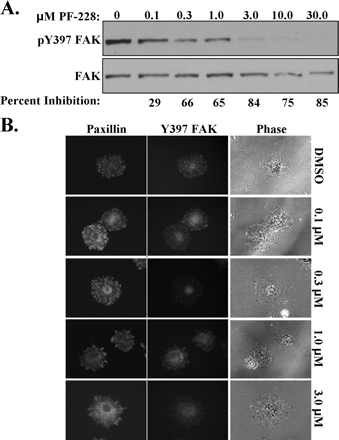This product is for research use only, not for human use. We do not sell to patients.

| Size | Price | Stock |
|---|---|---|
| 100mg | $415 | In Stock |
| 250mg | $699 | In Stock |
| 500mg | $1025 | In Stock |
Cat #: V0658 CAS #: 869288-64-2 Purity ≥ 98%
Description: PF-573228 (PF573228) is a selective and ATP-competitive FAK (focal adhesion kinase) inhibitor with potential antitumor activity. It inhibits FAK with an IC50 of 4 nM in a cell-free assay, and is ~50- to 250-fold more selective for FAK over other kinases including Pyk2, CDK1/7 and GSK-3β. PF-573228 shows high in vivo antitumor efficacy in PC3M-luc-C6 xenograft models. FAK is a non-receptor protein-tyrosine kinase that regulates integrin and growth factor signaling pathways involved in cell migration, proliferation, and survival. FAK is over expressed in many cancers, including breast and prostate cancer.
References: [1]. Slack-Davis JK, et al. Cellular characterization of a novel focal adhesion kinase inhibitor. J Biol Chem. 2007 May 18;282(20):14845-52
Publications Citing InvivoChem Products
Product Promise

- Physicochemical and Storage Information
- Protocol
- Related Biological Data
- Stock Solution Preparation
- Quality Control Documentation
| Molecular Weight (MW) | 491.49 |
|---|---|
| Molecular Formula | C22H20F3N5O3S |
| CAS No. | 869288-64-2 |
| Storage | -20℃ for 3 years in powder formr |
| -80℃ for 2 years in solvent | |
| Solubility In Vitro | DMSO: 26 mg/mL (52.9 mM)r |
| Water: <1 mg/mLr | |
| Ethanol: <1 mg/mL | |
| Solubility In Vivo | 30% PEG400+0.5% Tween80+5% propylene glycol: 30 mg/mL |
| SMILES Code | O=C1NC2=C(C=C(NC3=NC=C(C(F)(F)F)C(NCC4=CC=CC(S(=O)(C)=O)=C4)=N3)C=C2)CC1 |
| Synonyms | PF573,228; PF 573,228; PF-573,228; PF573228; PF 573228; PF-57322 |
| Protocol | In Vitro | In vitro activity: PF 573228 blocks the phosphorylation of FAK Tyr397 in REF52 cells, PC3 cells, SKOV-3 cells, L3.6p1 and F-G, MDCK cells with IC50 of 30-500 nM. However, PF 573228 (1 μM) with 80% inhibition of FAK phosphorylation fails to inhibit cell growth or apoptosis. Similar treatment of cells with PF-228 resulted in inhibition of serum or FN-directed migration and decreased focal adhesion turnover. Kinase Assay: Purified activated FAK kinase domain (amino acids 410–689) is reacted with 50 μM ATP, and 10 μg/well of a random peptide polymer of Glu and Tyr (molar ratio of 4:1), poly(Glu/Tyr) in kinase buffer (50 mM HEPES, pH 7.5, 125 mM NaCl, 48 mM MgCl2) for 15 min. Phosphorylation of poly(Glu/Tyr) is challenged with serially diluted compounds at 1/2-Log concentrations starting at a top concentration of 1 μM. Each concentration is run in triplicate. Phosphorylation of poly(Glu/Tyr) is detected with a general anti-phospho-tyrosine (PY20) antibody, followed by horseradish peroxidase-conjugated goat anti-mouse IgG antibody. The standard horseradish peroxidase substrate 3, 3', 5, 5'-tetramethylbenzidine is added, and Optical Density readings at 450 nm are obtained following the addition of stop solution (2 M H2SO4). The IC50 values are determined using the Hill slope model. Cell Assay: Cells (Squamous cell carcinoma (SCC) are plated for 48 hours before addition of PF-562271. After 3 days cells are fixed by addition of ice cold 25% trichloroacetic acid (TCA) solution prior to staining with Sulforhodamine B (SRB) dye solution. Plates are washed with 1% glacial acetic acid, air-dried and resuspended in 10 mM Tris buffer, pH 10.5 before reading absorbance at 540 nm. Curve fitting and generation of IC50 values is carried out using GraphPad Prism 4 software from six replicates. |
|---|---|---|
| In Vivo | In several human s.c. xenograft models, PF-562271 exhibits dose-dependent tumor growth inhibition, and produces maximum tumor inhibition for PC-3M, BT474, BxPc3, and LoVo ranging from 78% to 94% inhibition at doses of 25 to 50 mg/kg twice daily, without weight loss, morbidity, or death. PF-562271 (25 mg/kg by p.o.) leads to a significant decrease in tumor progression in both subcutaneous and bone metastasis PC3M-luc-C6 xenograft models. In a Huh7.5 hepatocellular carcinoma xenograft model, combination therapy of sunitinib and PF-562271 targets angiogenesis and tumor aggressiveness, and produces more significant anti-tumor effect than single agent by blocking tumor growth and impacting the ability of the tumor to recover upon withdrawal of the therapy. | |
| Animal model | PC3M-luc-C6 xenograft models | |
| Dosages | 25 mg/kg; Oral gavage |
| Solvent volume to be added | Mass (the weight of a compound) | |||
|---|---|---|---|---|
| Mother liquor concentration | 1mg | 5mg | 10mg | 20mg |
| 1mM | 2.0346 mL | 10.1731 mL | 20.3463 mL | 40.6926 mL |
| 5mM | 0.4069 mL | 2.0346 mL | 4.0693 mL | 8.1385 mL |
| 10mM | 0.2035 mL | 1.0173 mL | 2.0346 mL | 4.0693 mL |
| 20mM | 0.1017 mL | 0.5087 mL | 1.0173 mL | 2.0346 mL |
This equation is commonly abbreviated as: C1 V1 = C2 V2
- (1) Please be sure that the solution is clear before the addition of next solvent. Dissolution methods like vortex, ultrasound or warming and heat may be used to aid dissolving.
- (2) Be sure to add the solvent(s) in order.







































